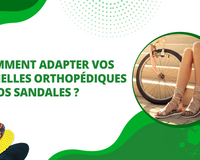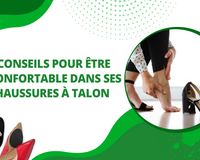You have just been diagnosed with orthopedic insoles to resolve a posture problem or plantar pain. You may not know it, but wearing orthopedic insoles is not enough to be healthier: you also have to pay attention to the shoes you wear! So, what shoes to wear with orthopedic insoles?
Wearing insoles with city sneakers

The basis when you are prescribed Orthopedic sole To improve your posture or relieve a back or plantar problem, is to wear closed shoes.
Closed shoes allow you better support for the foot and ankle, and above all your orthopedic insoles slip in easily.
City sneakers are ideal to wear with orthopedic insoles. They allow you to be comfortable in your shoes and provide you with more foot support.
The advantage is that sneakers also generally have a removable insole, which you can easily remove to slip in your own pair of orthopedic insoles.
It is recommended to wear city sneakers with a leather upper and sole to have more comfort in your shoes and a more cushioned sole for your arch.
❌ It is not recommended to wear city sneakers made of fabric or with a sole that is too thin. Typically, Converse type sneakers are not recommended for flat foot or foot problems. Plantar Fasciitis because they offer little support to your foot. What's more, it is more difficult to install your insole in a fabric high-top sneaker than a pair of low-top sneakers.
Wearing insoles with dress shoes

It is entirely possible to wear orthopedic insoles with dress shoes such as moccasins, derbies, or boat shoes.
The important thing when choosing your pair of dress shoes is to favor a thick sole, and a shoe that supports your foot well.
Typically, shoes with too thin a sole like ballerinas are not recommended for wearing orthopedic insoles. They do not provide good support for the foot, and do not offer enough support for your arch and heel.
Instead, opt for dress shoe models with a small heel to protect your heel and enjoy all the benefits of your orthopedic insoles.
Wear insoles with safety shoes
Safety boots are sturdy, high-top shoes. Used on construction sites, they protect your foot from shocks and provide good ankle support.
✅ Safety shoes are ideal to wear with orthopedic insoles. They limit the force of impact on the ground and combined with insoles, they provide total protection of the foot.
Depending on your pathology, you can even order safety shoes designed by podo-orthopedists to adapt to your foot: heel spur safety shoe, flat foot safety shoe, tendinitis safety shoe, plantar fasciitis safety shoe, etc.
The disadvantage is that this type of shoe is not easy to find in supermarkets, and you will often have to go to a specialized store or call on a specialist to be able to order them.
Wearing insoles with sports shoes

We can think that in general, sports shoes already offer great shock absorption and comfort which makes it possible to avoid wearing orthopedic insoles in them.
However, depending on your pathology, it is entirely possible to wear orthopedic insoles in your sports shoes.
The ideal remains to order orthopedic sports insoles specially adapted to your pathology.
Orthopedic insoles in your sports shoes will allow you to better protect your foot during your sports practice. The sole will absorb shock more effectively, and will offer you absolute comfort, practical when your sport lasts several hours!
However, it is advisable to go through a specialist practitioner before wearing orthopedic insoles during your sports practice, because not all insoles will be suitable for you. This can represent a larger budget than just ordering insoles online.
You will not wear the same sports shoes and insoles if you go climbing or run a marathon!
Wearing insoles with open shoes
In spring and summer, you may want to wear open shoes to avoid the heat. Flip-flops, sandals, slides: so many open beach or city shoes that allow you to enjoy summer temperatures.
The disadvantage of open shoes like flip-flops or sandals is that it is difficult and even not recommended to wear orthopedic insoles with it. These shoes generally have a thin sole, which does not protect your feet from shock, and a shape that does not provide good foot support.
Not only will it be difficult for you to slip orthopedic insoles in, but wearing open shoes risks causing pain in your feet.
To ensure that you don't hurt your feet or back with open shoes in the summer, it is advisable not to walk for too long with your shoes on (several hours in a row).
✅ You can also choose sandals with a thick leather or foam sole, like Birkenstocks, to ensure better shock protection.
However, wearing orthopedic insoles remains optional and complicated even in these latest models of open shoes.
Wearing Insoles with Heeled Shoes

In general, it is not recommended to wear heeled shoes with orthopedic insoles.
The too steep curve of heeled shoes prevents the sole from being positioned correctly, and you cannot benefit from its benefits for your feet.
❌ Pump style shoes or stiletto heels are not recommended for plantar problems. or wearing orthopedic insoles.
Some exceptions, however, allow you to wear heeled shoes with orthopedic insoles.
✅ If your shoes have a small block heel or a light wedge heel, then you can wear them with orthopedic insoles, taking care that they are well positioned.
Shoes such as ankle boots or boots with a small square heel, heeled derbies, can be combined with orthopedic insoles in winter or fall.
Overall, you should not wear your heeled shoes for too long or travel too many miles in them so as not to cause foot pain. The idea is to be able to wear your orthopedic insoles comfortably, to benefit from all their benefits on your feet.











